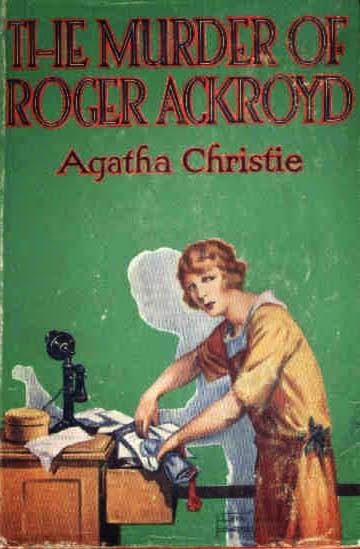
When Simon and I were debating Miss Marple v Poirot on our latest podcast (you can listen here), he said I should read The Murder of Roger Ackroyd, as it’s widely considered the best of Christie’s books. When Simon tells me to read something, I usually take heed, and it just so happened that Simon and I, along with some other lovely bloggers (of which there will be more anon) met a few days after the recording of the podcast to enjoy a literary walk across Hampstead Heath. Obviously no visit to Hampstead by book bloggers can be complete without a visit to the Book Shop of Death on Flask Walk (so named by me, as it is a serious health and safety hazard involving acrobatic, mountain climbing and contortion skills in order to access the books for sale), and the very first title I clocked on walking in just so happened to be a lovely green Penguin edition of The Murder of Roger Ackroyd. Evidently the book gods wanted me to read it, and so into my hands it came (thankfully at no risk to my life). I promptly began reading it on my way home, and was soon swept into the mystery of the murder of wealthy businessman Roger Ackroyd, stabbed to death in his study on a quiet summer evening in the village of King’s Abbott.
It has been a busy few days in King’s Abbott; Mrs Ferrars, a rich young widow, has just committed suicide, and rumours are flying. Many think that she killed her husband, and the guilt pushed her to finally take her own life. However, this seems a strange occurrence; she was happy, having been about to marry her neighbour, none other than Roger Ackroyd. What can have induced her to want to kill herself now, a year after her husband’s death? Ackroyd is distraught, and asks his good friend, and the narrator of the novel, kindly local doctor James Sheppard, to the house to talk things over with him. However, shortly after Dr Sheppard leaves that night, he receives a telephone call saying that Roger Ackroyd has been murdered; rushing back to the house, he finds that no one there has made such a telephone call. On breaking into the study, Ackroyd is indeed found dead, stabbed in the neck with his own ornamental dagger. The household, made up of Roger’s sister in law and niece, an old friend and the various servants, are quizzed, but all seem to have reasonable alibis apart from Ralph Paton, Ackroyd’s troublesome stepson, who has suspiciously disappeared. All of the evidence appears to point to Ralph being to blame for the murder, but Roger’s niece Flora, who was secretly engaged to Ralph, is insistent that he didn’t do it. Desperate to clear his name, she enlists the help of the newly retired Poirot, who has just moved in next door to Dr Sheppard, to help her.
Much excitement, intrigue and marvelous period details then ensue, with Christie demonstrating her mastery of intricate plotting in setting up a wide variety of characters with viable motives and fascinating histories to keep the reader guessing throughout. I changed my mind constantly, second guessing every character who passed through the quaint, slumbering village of King’s Abbott. However, the ending took me entirely by surprise; it has to be the best twist I have ever come across in a novel, and I was kicking myself for not seeing it coming when I realised how easily I had allowed myself to be taken in. If you haven’t read it, you must: it’s a quick and highly entertaining read that will have you absolutely in awe of how clever and brilliant Christie is. They don’t make them like this any more!
